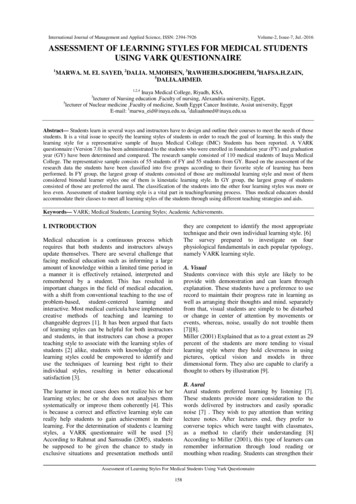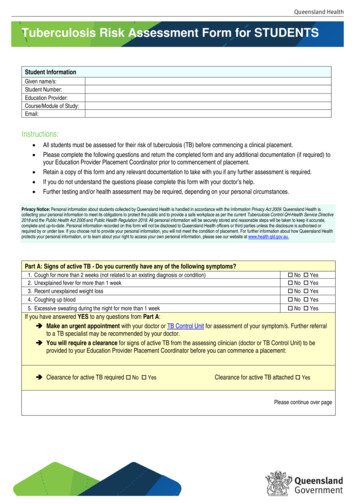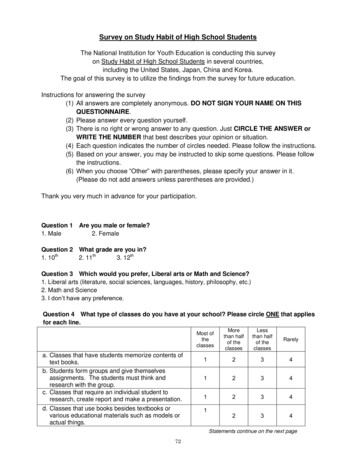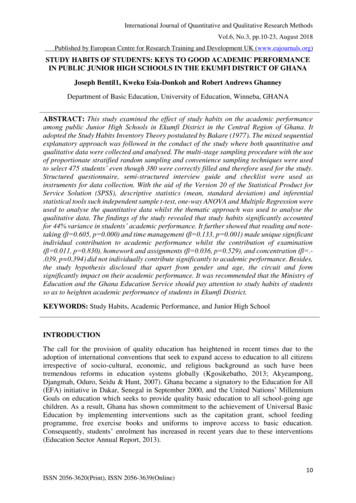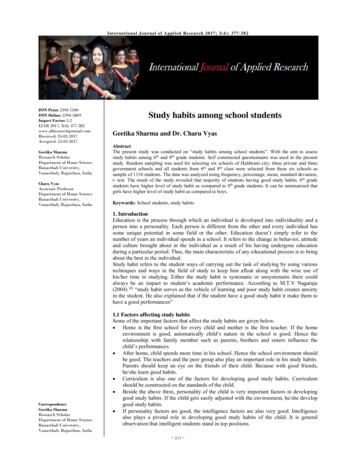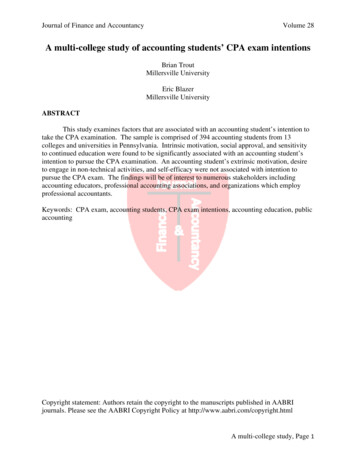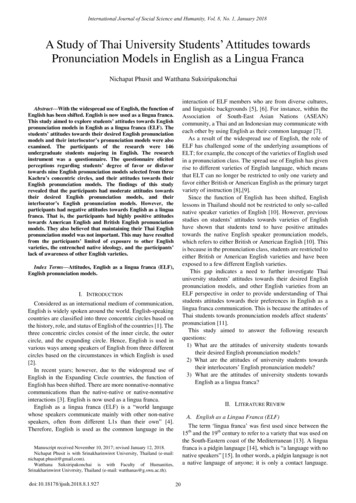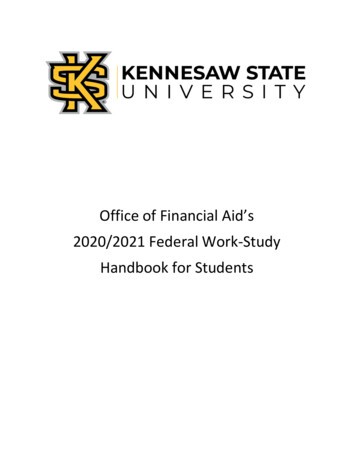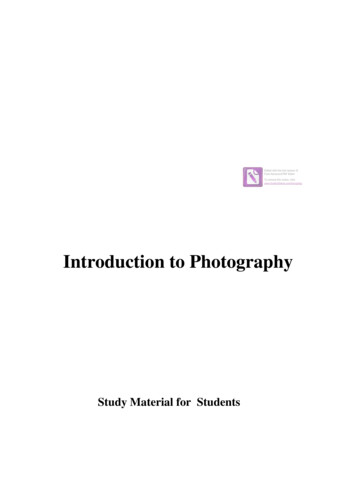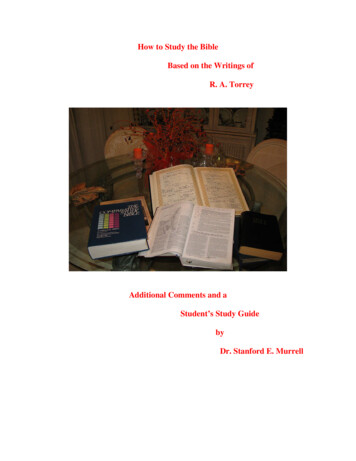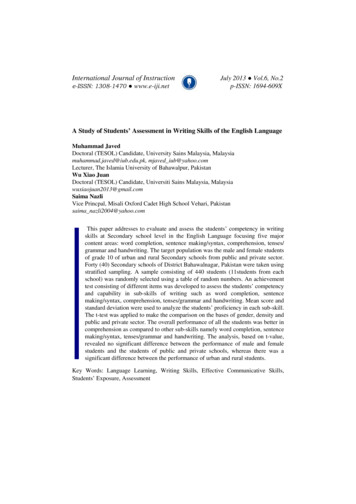
Transcription
International Journal of Instructione-ISSN: 1308-1470 www.e-iji.netJuly 2013 Vol.6, No.2p-ISSN: 1694-609XA Study of Students’ Assessment in Writing Skills of the English LanguageMuhammad JavedDoctoral (TESOL) Candidate, University Sains Malaysia, Malaysiamuhammad.javed@iub.edu.pk, mjaved iub@yahoo.comLecturer, The Islamia University of Bahawalpur, PakistanWu Xiao JuanDoctoral (TESOL) Candidate, Universiti Sains Malaysia, Malaysiawuxiaojuan2013@gmail.comSaima NazliVice Princpal, Misali Oxford Cadet High School Vehari, Pakistansaima nazli2004@yahoo.comThis paper addresses to evaluate and assess the students’ competency in writingskills at Secondary school level in the English Language focusing five majorcontent areas: word completion, sentence making/syntax, comprehension, tenses/grammar and handwriting. The target population was the male and female studentsof grade 10 of urban and rural Secondary schools from public and private sector.Forty (40) Secondary schools of District Bahawalnagar, Pakistan were taken usingstratified sampling. A sample consisting of 440 students (11students from eachschool) was randomly selected using a table of random numbers. An achievementtest consisting of different items was developed to assess the students’ competencyand capability in sub-skills of writing such as word completion, sentencemaking/syntax, comprehension, tenses/grammar and handwriting. Mean score andstandard deviation were used to analyze the students’ proficiency in each sub-skill.The t-test was applied to make the comparison on the bases of gender, density andpublic and private sector. The overall performance of all the students was better incomprehension as compared to other sub-skills namely word completion, sentencemaking/syntax, tenses/grammar and handwriting. The analysis, based on t-value,revealed no significant difference between the performance of male and femalestudents and the students of public and private schools, whereas there was asignificant difference between the performance of urban and rural students.Key Words: Language Learning, Writing Skills, Effective Communicative Skills,Students’ Exposure, Assessment
130A Study of Students’ Assessment in Writing Skills INTRODUCTIONLanguage is an effective way of communication of our feelings. Therefore, It is may beconfined only to human beings for communication intention. Carney (1990) definedlanguage as a set of a few specified vocal symbols that help the human beings tocommunicate with others. According to Hadely (2001), language is a set of sounds bymeans of which feelings, thoughts and sentiments are conveyed to other human beings.A newly born baby is unable to speak. The child learns the language with the passageof time as he/she interacts with others. In the beginning he makes various meaninglessisolated sounds. It takes time to learn a language. Finally he acquires language andgrammatical construction of the language of his group by imitation. Human language istransferred from one generation to another generation through a sound learning process.Language acquisition is contrasted with language learning which is used with referenceto a second language which a person learns deliberately; particularly in formal settingslike school etc. The researchers like Littlefair (1991), Dockrell and Messer (1988), andWiddowson, (1978) distinguished language acquisition from language learning andused the expression of first language acquisition in contrast with second languagelearning but many researchers and theorists don’t distinguish between the two. Farzan(2000) for instance, treated language acquisition as a purely stylistic alternate tolanguage learning.The four main skills of the English language are reading, listening, speaking, andwriting. A person needs a mastery of various elements to use the language to conveythoughts, wishes, intentions, feeling and information in a written form (Pamela, 1991).The four basic English language skills are divided into two categories such as receptiveskills and productive skills. Reading and listening are considered receptive skillswhereas speaking and writing are known as productive skills. Writing is one of the fourbasic skills. The students start learning to communicate through written form as theybegin to interact with others at school level. The writing skill is more complicated thanthat of other language skills. Even sometimes a native speaker of the English languagemay experience complication in a tricky situation. Basically the writing skill requires awell-structured way of the presentation of thoughts in an organized and planned way(Braine & Yorozu, 1998). Advanced writing skill is one of the basic requirements forbetter academic performance as well as other activities related to writing presentation(National Assessment of Educational Progress, 2002).Writing is the one of the basic skills of the English language. It is generally consideredone of the most difficult that other skills for foreign language students. Even nativespeakers feel difficulty in showing a good command of writing. (Johnstone, Ashbaugh,& Warfield, 2002). The ESL teachers include writing skills in the syllabus because thisis an essential element for students' academic success. (Kellogg, 2008) because writinghelps to i) reinforce the grammatical structure, ii) enhance the students’ vocabulary, iii)and assist other language skills such as reading, listening and speaking.Writing success is used multifarious purposes at school level. Providing assistance tothe students inside and outside the classroom, awarding a grade, selection of studentsInternational Journal of Instruction, July 2013 Vol.6, No.2
131Javed, Juan & Nazlifor appropriate courses, evaluation of programs are considered important aspects ofassessment in writing skill. The process of assessment of written literacy should be wellorganized and well managed to make it transparent and meaningful ((Elander,Harrington, Norton, Robinson, & Reddy, 2006)Review of the Related LiteratureThe ability to write something in a productive way is an indicator of success during thelearning process (Geiser & Studly, 2001). Academic achievement is considered as atoken of a good indicator in language learning process (Benjamin & Chun, 2003).The productive writing skill is considered a cognitive challenge, because it helps toassess language competency, recalling capability and thinking ability. It demands torecall information from long-term memory (Kellogg, Olive, & Pilot, 2001). Moreover,the ability of productive writing requires sound ability of thinking on comprehensiblematters (Nickerson, Perkins, & Smith, 1985).Carney (1990) found that 95% high school English teachers opine writing as animportant but only 19% assign it as an unimportant task because the process ofassessment is time consuming especially for lengthy assignments. At college anduniversity level, marking of students writing is both laborious and too little rewardedand appreciated by the administration. According to Bok (2006), the writing skill of thestudents has been declining even in American students.The cognitive domain has focused more on reading skill and numeracy than that ofwriting skill (Levy, & Ransdell, 1995; Hayes & Flower, 1986; Rijlaarsdam et al.,2005). However Garcia (2008) designed Waking Minds Writing (WMW) as web-basedsupplemental writing program that can assist the English Language Learners indeveloping their exposure and ability in writing. WMW helps to devise a plan to teachthe students well in all genres of writing. This program provides instruction to improvegrammatical structure and syntax. It also provides the guidelines for solid assessmentand evaluation.The process of mature writing requires a well organized planning (Hayes & Flower,1980; Levy & Ransdell, 1995), the writer is involved in content problem and rhetoricalproblem. Furthermore, an adequate memory helps to accelerate this process (Bereiter &Scardamalia 1987; Scardamalia & Bereiter, 1991).The command over handwriting and spelling is also an essential element for writing. Itassists the students to make their writing skill more meaningful and communicative(McCutchen, 1996; Graham, Berninger, Abbot, Abbot, & Whitaker, 1997; Graham &Harris, 2000).Micro-Skills of WritingHenry (2000) mentioned the micro-skills involved in writing skills. Mastery of thesemicro-skills helps the writer to have good command over writing free of mistakes anderrors. In the process of micro-skills the writer needs to:1. use the script, spellings and punctuations correctly.2. apply the accurate words to state the right tense, case and gender.International Journal of Instruction, July 2013 Vol.6, No.2
132A Study of Students’ Assessment in Writing Skills 3.make use of major components such as subject, verb and object etc.appropriately which can convey the thought of writer clearly to the reader.4. make the text coherent to make the reader understand easily.5. place all parts of speech properly.6. apply the vocabulary and terminologies appropriately.7. use the style of writing suitably to the requirements of the audience.8. clarify the central ideas from the sustaining information.9. avoid from jargon, slang, taboos and keep in mind the standard of languageaccording to the mental level of the reader.10. judge about the prior knowledge of the audience about the subject.Pylkkänen and McElree (2006) added that the students have to construct sentencesbearing in mind grammatical coordination, appropriate lexis and correct spellings. Itcan be said that this is the best way of improving writing skills.Writing at the secondary stageWriting in this context, especially with reference to a language classroom in asecondary school, means learning and practicing the grammar of a language throughwritten exercises. The students learn to write the sentences grammatically correct inorthography. Wren and Marten (2006) also narrated that the student has to constructsentences keeping in mind grammatical synchronization and variation, not to mentionusing appropriate terminology and correct spellings. At this stage the learner is likely toview words as entities of grammar, and to concentrate on the morphological changesnecessary to sentence construction, rather than to see them as vehicles of meaning,through which he can communicate.The ultimate meaning of writing skill is to construct grammatically correct sentencesand to communicate a meaning to the reader. Real life communicative writing tasks, onthe other hand, are letter-writing, form filling, report writing and so on. Thesecommunicative writing tasks are rarely practiced in our language classrooms.Communicative writing should be logical and coherent. Cohesion; the grammatical orstructural unity and coherence; the unity of sense or meanings are also essential forhigh-quality writing (Shahid, 1999). Moreover the communicative writing must have apurpose and logic.Writing can be divided into sub-skills like descriptive, narrative and expository writingskills (Wilcox, 2002). The style of what is written will automatically be affected by thestatus of the addressee, age, profession and relationship with the writer.Hywel (2003) bifurcated the sub-skills of writing such as descriptive skill (descriptionof people, places and things), narrative skill (narrating stories, incidents, events withproper sequence in chronological order) and expository skill (writing with the purposeto justify, explain, define, classify, compare and contrast).English is taught as a compulsory subject from class one up to graduation level inPakistan. English is not the mother tongue of Pakistani students. It is a second languagefor them. That’s why they feel it difficult to learn. The majority of the students think areInternational Journal of Instruction, July 2013 Vol.6, No.2
133Javed, Juan & Nazlihandicapped and feel an inferiority complex due to the lack of competency in thesubject of English. Acquiring facility in English gaining popularity in Pakistan in allwalks of life day by day and has become a status symbol and key to success. Therefore,this study is an attempt to evaluate the Pakistani students’ exposure in writing subskills.Objectives of the StudyThe major objectives of the study were bifurcated into following categories:i) To find out students’ competency in different types of sub-skills of writing.ii) To compare the students’ proficiency in sub-skills of writing on the basis of gender,location, and public and private sector.METHODThe target population consists of the students of grade 10 from Secondary schools.Three major strata: male and female students, rural and urban students and the studentsof public and private schools were determined in this study. Twenty Boys Secondaryschools (ten from rural [5 public and 5 private] and ten from urban areas [5 public and 5private]) and similarly, twenty Girls Secondary schools (ten from rural [5 public and 5private] and ten from urban areas [5 public and 5 private]) were selected using stratifiedsampling technique. The total population was 1375 students studying in grade 10 in theDistrict Bahawalnagar, Pakistan. A sample consisting of 440 students (11students fromeach school) was randomly selected using a table of random numbers from 40Secondary Schools of the District Bahawalnagar which is 32 % of the existingpopulation.Research InstrumentAn achievement test was designed to assess the students’ competency in writing subskills. Different items related to writing skills namely word completion, sentencemaking/syntax, comprehension, tenses/grammar and handwriting were included in thetest. Nanda and Khatoi (2005) specified such type of items for such type of research.The material for achievement test was taken from the textbook for grade 10 studentsrecommended by the Punjab Text Book Board. The students were directed to completethe achievement test. Writing test consisting of 05 sections was for thirty (30) marks.Allowed time was twenty-five (25) minutes for the achievement test.The validity of the instrument was tested by language experts’ opinions, followed by apilot study on a small scale. The items of the instrument were improved in the light oflanguage experts’ opinions. The reliability of the instrument was found at 0.917Cronbach’s Alpha which was acceptable to launch the study at large scale (Gay, 2000).Data Collection and AnalysisThe written permission from all the heads of the institutions was taken beforeconducting the test. The data was collected personally. Class teacher of each respectiveschool helped out the researcher in administering the test. The separate room in calmInternational Journal of Instruction, July 2013 Vol.6, No.2
134A Study of Students’ Assessment in Writing Skills and quiet environment was chosen in each school. To seek high response rate, theconvenient time for each school administration was chosen.The data was analyzed on scoring basis namely one mark against one item. The correctresponse got Mark 1 and incorrect received mark zero. The analysis was made in twostages.In the first stage, focusing on the descriptive statistics, the data were analyzed in thefollowing three steps.Step 1: The average score and frequency of each item were calculated. The whole datawas fed in the form of master table to tabulate into different variables.Step 2: The standard deviation was calculated that determined the variation in thescores. It assisted to identify the dispersion of scores around the mean value.Step 3: The tables were drawn to show the frequencies, mean scores and standarddeviations.In the second stage, an analysis through the use of t-test for independent samples toinvestigate significant difference at p 0.05 in male and female students, the students ofrural and urban areas and the students of public and private schools was made asstatistical inference.RESULTSEach item was analyzed separately. The performance of different variables namelygender, location and public and private sectors was analyzed separately. However itwas not possible to present all those results here which expanded to 40 tables. Hence, aresult of the study is given here in eight tables only. The competency in writing subskill was evaluated on the basis of Grading Formula prescribed by The Boards ofIntermediate and Secondary Education in Pakistan, e.g. (i) 80% and above Exceptional (ii) 70-79% Excellent (iii) 60-69% Very good (iv) 50-59% good (v)40-49% Fair (vi) 33-39% Satisfactory (vii) 0-32% Fail/very poor.Table 1: Performance of the students in the completion of words: (n 440)StatementFill in the missinglettersAnnexure AQuestion No.1 (a)Sr. No.123456WordsDisc plineOpp rtunityPoll tionR v lationOc as 770.280.640.55SD0.160.170.130.140.160.15Table 1 indicates that the students’ scores in question No 1, 2, 3, 4 and 5, are 67%,38%, 77%, 28% and 64% respectively. In this way their performance in the questionNo 3rd is ‘excellent’ and remained ‘very good’ in question. 1st and 5th whereas theyshowed ‘satisfactory’ performance in question No 2 and ‘very poor’ in question No.4.The mean score (55) showed their overall performance as ‘good’ in this section.International Journal of Instruction, July 2013 Vol.6, No.2
135Javed, Juan & NazliTable 2: Performance of the students in sentence making/syntax: (n 440)StatementSr. No.Use these words inyour own sentencesAnnexure AQuestion No.1 (b)123456WordsEnjoyWithNationQuicklyUps and 70.640.480.370.53SD0.170.170.160.180.160.17Table 2 indicates that the students’ scores in question No 1, 2, 3, 4 and 5 are 61%, 57%,64%, 48% and 37% respectively. In this way their performance in the question No. 1stand 3rd is ‘very good’ and remained ‘good’ in Question No.2nd and ‘fair’ in QuestionNo. 4, whereas they showed ‘satisfactory’ performance in question No 5. The meanscore (53) showed their overall performance as ‘good’ in this section. Moreover thearithmetic mean scores indicate that the students’ performance is comparatively betterin making sentences of ‘Verb’ (enjoy; Q.1) and ‘Noun’ (nation; Q.3) and lowest scoresin making sentence of ‘preposition’ (with; Q. 2), ‘adverb’ (quickly; Q.4), and idiom(Ups and downs; Q.5).Table 3: Performance of the students in comprehension: (n 440)StatementRead the passage andanswer the followingquestions.Annexure AQuestion No.1 (c)Sr. No.123456Q. ding to Table 3, the students’ scores in question No 1, 2, 3, 4 and 5, are 91%,77%, 63%, 39% and 57% respectively. In this way the students’ performance was‘exceptional’, ‘excellent’, ‘very good’, satisfactory’, and ‘good’ in Question No. 1st, 2nd,3rd, 4th and 5th respectively. The mean score (53) falls in the category of ‘good’ in thissection.Table 4: Performance of the students in Tenses/grammar: (n 440)Sr. No.Statement1Put the proper2form of the verbin the blank3spaces.4Annexure A5Question No.1 (d)6TensesPast Indefinite TensePast Perfect Continuous tensePresent Perfect TenseFuture Indefinite TensePast Indefinite Tense (Passive Voice)AverageFrequency 170.160.180.180.170.17According to the Table 4, the students’ performance was ‘very good’ in ‘past perfectcontinuous tense’ (Q. No. 2) whereas their performance remained ‘good’ in pastindefinite tense (Q. No. 1), Present Perfect Tense (Q. No. 3), Future Indefinite TenseInternational Journal of Instruction, July 2013 Vol.6, No.2
136A Study of Students’ Assessment in Writing Skills (Q. No. 4) and Past Indefinite Tense; Passive Voice (Q. No. 5). The mean score (57)also falls in the category of ‘good’ in this section.Table 5: Performance of the students in handwriting: (n 440)StatementSr. No.1234567891011Rewrite thesewords in goodhandwriting keeping inmind the four lines.Annexure AQuestion No.1 .170.170.170.180.180.170.180.180.170.170.17Table 5 indicates that the students’ scores in question No 1, 2, 3, 4, 5, 6, 7, 8, 9 and 10,are 62%, 57%, 62%, 49% 47%, 58%, 49%, 50%, 41%, and 43% respectively. In thisway their performance in the question No. 1st and 3rd is ‘very good’ and remained‘good’ (Appendix B) in the 2nd, 6th, and 8th whereas they showed ‘fair/poor’performance (Appendix C) in question No 4, 5, 7, 9, and 10. The mean score (52)showed their performance as ‘good’ in this section. The results also indicate thatstudents can write easily those words which lie on upper three lines (e.g. Sadder andConsonant, etc) but they feel difficulty in writing those words which lie on four lines(e.g. Zoology, Psychology and Philosophy etc.).Table 6: Comparison of male and female students’ performance in writing sub-skills: n(Male) 220, n (Female) 220Male StudentsSN123456SkillsWord completionSentencesmaking/ syntaxComprehen sionTenses/ grammarHand writingAverageFemale 0.560.250.140.150.19t-value-1.470607These two types of hypotheses were made to compare the performance on a genderbasis:1- Ho: There is no significant difference between the performance of male and femalestudents in writing skills.2- H1: There is a significant difference between the performance of male and femalestudents in writing skills.A comparison between the performance of male and female students has been made inTable 6 on the basis of above mentioned hypotheses. The results revealed no statisticalInternational Journal of Instruction, July 2013 Vol.6, No.2
137Javed, Juan & Nazlisignificant difference between the performance of male and female students in theproficiency of writing skills. The t-value (-1.470607) for writing skills was notsignificant at p 0.05 level of significance, because this calculated t-value lies inbetween accepted region, therefore the null hypothesis (1-Ho) was accepted and it canbe said that the performance of male and female students was similar. The averagemean scores for the male and female students were 0.59 and 0.56 respectively.Table 7: Comparison of rural and urban students’ performance in writing sub-skills: n(Rural) 220, n (Urban) 220Rural StudentsS. N123456SkillsWord completionSentences gAverageUrban 0.620.210.130.150.18t-value3.570124These two types of hypotheses were made to compare the performance of urban andrural students.2- Ho: There is no significant difference between the performance of urban and ruralstudents in writing skills.2- H1: There is a significant difference between the performance of urban and ruralstudents in writing skills.In the light of these hypotheses a comparison between the performance of urban andrural students was made in the Table 7. The results revealed a significant differencebetween the performance of urban and rural students in the writing sub-skills. The tvalue (3.570124) was significant at p 0.05 level of significance (which is close tozero), because this calculated t-value does not lie in between the accepted region,therefore the null hypothesis (2-Ho) was rejected and it can be concluded that theperformance of urban and rural students was not same in writing sub-skills. Theaverage mean scores for the rural and urban students were 0.53 and 0.62 respectively.Table 8: Comparison of the students of public and private schools in writing sub-skills:n (Male) 220, n (Female) 220Public School StudentsS. N Skills123456Private School 20.510.14Average1250.570.191280.580.18Word completionSentencesmaking/ onal Journal of Instruction, July 2013 Vol.6, No.2
138A Study of Students’ Assessment in Writing Skills These two types of hypotheses were made to compare the performance of the studentsof public and private schools in writing skill:3-Ho: There is no significant difference between the performance of the students ofpublic and private schools in writing skills.3-H1: There is a significant difference between the performance of the students ofpublic and private schools in writing skills.A comparison between the performance of the students of public and private schools inwriting skills was made in the Table 8. The results revealed no significant statisticaldifference between the performance of the students of public and private schools inwriting sub-skills. The t-value (-0.527514) for writing sub-skills was not significant atp 0.05 level of significance, because this calculated t-value lies in between acceptedregion, therefore the null hypothesis (3-Ho) was accepted and it can be concluded thatthe performance of the students of public and private schools was the same. Theaverage mean scores of the students of public schools and students of private schoolswere 0.57 and 0.58 respectively.DISCUSSION AND CONCLUSIONWriting skill plays a pivotal role to improve students’ exposure and competency for thepurpose of communication and interaction. According to the nature of the examinationsystem in Pakistan, the students are required to show their worth in writing in theclassroom and examination hall as well. According to the results of this study, it can beconcluded that the students can fill the missing letter where a single letter is required tofill in a word rather than filling the missing letters where more than one letter isrequired in a word (Table 1). The results of this study reflect that students can usecommon parts of speech like verbs and nouns in sentences but they feel difficulty inmaking sentences of adverbs and idioms. (Table 2).The results of this study revealed that the students’ mean scores in ‘word completion’,‘sentence making/syntax’, ‘comprehension’, ‘tenses/grammar’ and ‘handwriting’ were55% (Table 1), 53% (Table 2), 66% (Table 3), 57% (Table 4) and 52% (Table 5)respectively. These results show that the students got the lowest marks (52%) inhandwriting as compared to other sub-skills. With regards to the handwriting, theresearch carried out by Connelly, Dockrell, and Barnett, (2005) also showed that thestudents feel difficulty to produce legible handwriting. On the other hand, these resultsindicate that the students showed better performance in comprehension (Table 3) ascompared to other writing sub-skills.To investigate the difference in students’ performance in the writing sub-skills ongender bases was one of the key objectives of this study. The null hypothesis (1-Ho) tobe tested was, ‘there is no significant difference between the performance of male andfemale students in writing skills’. For this Independent Sampling, t-test was applied toinvestigate the difference between the performance of male and female students (Table6). These results are similar to the findings of the research done by Berninger et al(1997). Contrary to this, the findings regarding the gender differences are different thanInternational Journal of Instruction, July 2013 Vol.6, No.2
Javed, Juan & Nazli139that of the research carried out by Pajares, Miller, and Johnson (1999). Pajares, Miller,and Johnson (1999) found that girls performed better than boys. The results of thepresent research revealed that there is no significance difference between theperformance of male and female students in the competency of writing sub-skills. Theresults also indicate that the students’ performance in ‘past perfect continuous tense’was comparatively better than that of other tenses mentioned in Table 3. As regardshandwriting, the students showed better performance in writing those words that lie onupper three lines but they feel difficulty in writing those words which lie on four lines(Table 5).Another objective of this study was to find out the difference between the performanceof the urban and rural students in writing sub-skills. The difference between meanscores of urban and rural students in writing skill was 0.09 which shows a difference inthe performance of the urban and rural students in writing skill. The t-value (3.570124)is significant at p 0.05 level of significance, therefore the null hypothesis was rejectedas can be seen in Table 7. Therefore, the students of the urban areas showed betterperformance as compared to the students of rural areas. These results are similar to thefindings of the research carried out by Mahyuddin et al (2006). According toMahyuddin et al (2006), there is a gap between the achievements of rural and urbanlearners.With regards to the performance of the students of public and private schools, there isno significant difference in the performance of the public and private school students inwriting sub-skills. The t-value (-0.527514) for writing sub-skills was not significant atp 0.05 level of significance, because this calculated t-value lies in between theaccepted region, therefore the null hypothesis (3-Ho); ‘there is no significant differencebetween the performance of the students of public and private schools in writing skills’was accepted and it can be concluded that the performance of the students of public andprivate schools was the same. Whereas Witte (1992) found in his research that therewas a difference between the performance of the students of public and privateinstitutions.RECOMMENDATIONSOn the basis of the findings and conclusions, the following recommendations are putforward for the students, teachers and adminis
Henry (2000) mentioned the micro-skills involved in writing skills. Mastery of these micro-skills helps the writer to have good command over writing free of mistakes and errors. In the process of micro-skills the writer needs to: 1.
